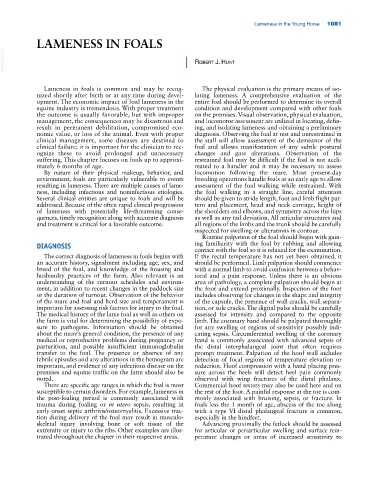Page 1115 - Adams and Stashak's Lameness in Horses, 7th Edition
P. 1115
Lameness in the Young Horse 1081
LAMENESS IN FOALS
VetBooks.ir roberT J. hunT
Lameness in foals is common and may be recog The physical evaluation is the primary means of iso
nized shortly after birth or at any time during devel lating lameness. A comprehensive evaluation of the
opment. The economic impact of foal lameness in the entire foal should be performed to determine its overall
equine industry is tremendous. With proper treatment condition and development compared with other foals
the outcome is usually favorable, but with improper on the premises. Visual observation, physical evaluation,
management, the consequences may be disastrous and and locomotor assessment are utilized in locating, defin
result in permanent debilitation, compromised eco ing, and isolating lameness and obtaining a preliminary
nomic value, or loss of the animal. Even with proper diagnosis. Observing the foal at rest and unrestrained in
clinical management, some diseases are destined to the stall will allow assessment of the demeanor of the
clinical failure; it is important for the clinician to rec foal and allows manifestation of any subtle postural
ognize these to avoid prolonged and unnecessary changes and gate alterations. Observation of the
suffering. This chapter focuses on foals up to approxi restrained foal may be difficult if the foal is not accli
mately 6 months of age. mated to a handler and it may be necessary to assess
By nature of their physical makeup, behavior, and locomotion following the mare. Most present‐day
environment, foals are particularly vulnerable to events breeding operations handle foals at an early age to allow
resulting in lameness. There are multiple causes of lame assessment of the foal walking while restrained. With
ness, including infectious and noninfectious etiologies. the foal walking in a straight line, careful attention
Several clinical entities are unique to foals and will be should be given to stride length, foot and limb flight pat
addressed. Because of the often rapid clinical progression tern and placement, head and neck carriage, height of
of lameness with potentially life‐threatening conse the shoulders and elbows, and symmetry across the hips
quences, timely recognition along with accurate diagnosis as well as any tail deviation. All articular structures and
and treatment is critical for a favorable outcome. all regions of the limbs and the trunk should be carefully
inspected for swelling or alterations in contour.
Routine palpation of the foal should begin with gain
DIAGNOSIS ing familiarity with the foal by rubbing and allowing
contact with the foal so it is relaxed for the examination.
The correct diagnosis of lameness in foals begins with If the rectal temperature has not yet been obtained, it
an accurate history, signalment including age, sex, and should be performed. Limb palpation should commence
breed of the foal, and knowledge of the housing and with a normal limb to avoid confusion between a behav
husbandry practices of the farm. Also relevant is an ioral and a pain response. Unless there is an obvious
understanding of the turnout schedules and environ area of pathology, a complete palpation should begin at
ment, in addition to recent changes in the paddock size the foot and extend proximally. Inspection of the foot
or the duration of turnout. Observation of the behavior includes observing for changes in the shape and integrity
of the mare and foal and herd size and temperament is of the capsule, the presence of wall cracks, wall separa
important for assessing risk factors for injury to the foal. tion, or sole cracks. The digital pulse should be carefully
The medical history of the lame foal as well as others on assessed for intensity and compared to the opposite
the farm is vital for determining the possibility of expo limb. The coronary band should be palpated thoroughly
sure to pathogens. Information should be obtained for any swelling or regions of sensitivity possibly indi
about the mare’s general condition, the presence of any cating sepsis. Circumferential swelling of the coronary
medical or reproductive problems during pregnancy or band is commonly associated with advanced sepsis of
parturition, and possible insufficient immunoglobulin the distal interphalangeal joint that often requires
transfer to the foal. The presence or absence of any prompt treatment. Palpation of the hoof wall includes
febrile episodes and any alterations in the hemogram are detection of focal regions of temperature elevation or
important, and evidence of any infectious disease on the reduction. Hoof compression with a hand placing pres
premises and equine traffic on the farm should also be sure across the heels will detect heel pain commonly
noted. observed with wing fractures of the distal phalanx.
There are specific age ranges in which the foal is most Commercial hoof testers may also be used here and on
susceptible to certain disorders. For example, lameness in the rest of the foot. A painful response at the toe is com
the post‐foaling period is commonly associated with monly associated with bruising, sepsis, or fracture. In
trauma during foaling or in utero sepsis, resulting in foals less the 1 month of age, abscess of the toe along
early‐onset septic arthritis/osteomyelitis. Excessive trac with a type VI distal phalangeal fracture is common,
tion during delivery of the foal may result in musculo especially in the hindfeet.
skeletal injury involving bone or soft tissue of the Advancing proximally the fetlock should be assessed
extremity or injury to the ribs. Other examples are illus for articular or periarticular swelling and surface tem
trated throughout the chapter in their respective areas. perature changes or areas of increased sensitivity to

